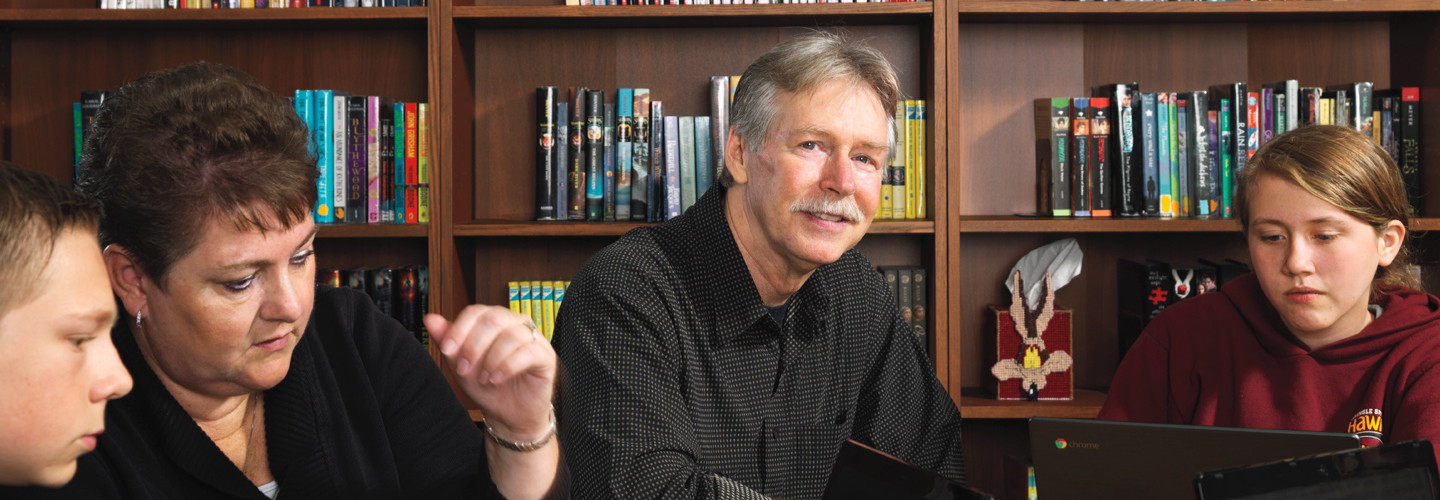Making Technology Integral to the Construction Plan
Getting the funding and the go-ahead to build a new school provides more than just freshly painted walls, bigger classrooms, better lighting and a modern design. It’s also an opportunity for schools to upgrade to a modern-day digital learning environment and to future-proof their technology infrastructure — but planning, timing and patience are key.
Take the California Montessori Project (CMP), a public charter school network in the Sacramento region. When new school construction funds were released in 2012, CMP committed to building two new schools. At the same time, CMP was beginning an extensive renovation project at its Carmichael site.
CMP Executive Director/Superintendent Gary Bowman and IT Department Lead Jacky Murray saw this as the perfect opportunity to make a long-term commitment to bringing the organization’s technology capabilities in line with evolving academic needs. Not only would officials outfit the newest schools with the latest technology, but they also leveraged the construction process and its economies of scale and bulk-discount opportunities. Doing so allowed the district to retrofit existing schools with new technology more cost-effectively.
“It’s really important for us to have consistency in programming and operation,” Bowman says, noting that the organization serves more than 2600 students on seven campuses. “We didn’t want a situation where some students were at a disadvantage because they had less access to technology. It seemed better to address all the schools at the same time.”
Follow the Child
Clearly, the fast-growing charter school network was ready for a technology boost, says Murray, who notes the IT environment at existing schools was extremely limited. There was no wide area network connecting the different campuses. The schools had little Wi-Fi coverage or bandwidth. Cabling was old, and the network was a mish-mash of pass-through devices and off-the-shelf switches.
CMP integrates technology into its program as it seeks to honor the Montessori philosophy of “following the child” using cloud-based applications and self-paced tech-assisted curriculum for tech-assisted curricula for foreign language instruction, math, reading and other subjects, and, more recently, electronic statewide testing. Murray notes that the network was always so bottlenecked that students couldn’t make effective use of those programs.
“We had to spend a lot of time planning and managing who was going to be on the Internet and when because we could only have a few students online at the same time,” Murray says.
Officials first sat down with architects and construction contractors to design and plan out the two new campuses and technology upgrades in 2011. Murray and Bowman attended that first meeting and continued to sit in on weekly planning and status sessions until the final project, the campus at Shingle Springs, was completed in the fall of 2015.
Murray decided early on to deploy Chromebooks because they are affordable and provide needed flexibility.
To connect all the campuses, the organization installed a WAN that provides 100Mbps speeds at each site. To boost wireless connectivity and cloud computing capabilities, Murray’s team designed wireless networks at each campus that feature Cisco Systems Catalyst 3560 and 2960 switches, Aerohive access points of varying speeds, Cisco Cloud Web Security, Cisco ASA firewalls and ScanSafe content filtering.
The construction projects and technology retrofits were completed by the fall of 2015, and Murray says that the decision to leverage new construction with an organizationwide technology upgrade is paying off.
“All of our students, no matter where they are, can directly and consistently access the computer-based curriculum at any time,” she says. “The students are more capable of managing their workloads. We’re seeing a vastly improved amount of student creativity, and that’s because they can interact with their teachers in real time in an environment that is stable and smooth.”
Adaptive Technology
When officials for Alexandria Public Schools in Alexandria, Minn., decided in 2011 to build a new $70 million high school, they wanted to include a technology infrastructure that would accommodate academic demand, and they wanted the building to reflect the way students use technology.
Although the school has a one-to-one initiative using Chromebooks, the wireless network is designed to accommodate as many as four wireless devices per student. Each classroom is outfitted with five collaboration stations featuring a large monitor and computer, along with a wireless keyboard and mouse.
Flexible Setup
With this setup, up to six students can work together to quickly create Google presentations. Throughout the school, students will find designated charging stations, myriad accessible electrical outlets, collaboration rooms, sitting areas with comfortable, moveable furniture and natural lighting — all designed to allow students to stop, sit, congregate and use their devices for study or communication.
“From the learning standpoint, we wanted the school and the environment to be very flexible so students could work independently and collaboratively, not just within the classroom but wherever they needed to on campus,” says Principal Chad Duwenhoegger.
It also was critical that the school keep up with advancing technology, says Kevin Brezina, the school’s technology director.
“We were trying to predict where technology and the learning environment might be 40, 50, 60 years down the road and how we could best accommodate that in our building design and planning,” Brezina says.
Early on, the school reached out to a consultant for outside-of-the-box thinking on a sustainability plan. As a result, the school’s interior, for example, is made up of modular walls that allow the school to easily reconfigure classrooms, offices and other spaces as needed.
The infrastructure, with a strong emphasis on wireless connectivity, is extremely robust but uses components that can be quickly upgraded at minimal cost. Classrooms, labs and other spaces boast multiple tech and electrical ports and data drops to handle as yet unknown technology demands.
“We’re not teaching technology anymore — technology is what we use to learn,” Duwenhoegger says. “If a student forgets his or her Chromebook, they really can’t participate in class. That’s how integral technology is at this school. The building reflects that.”
Build for Future Capacity
For officials at Western Maricopa Education Center (West-MEC), adaptive technology also was a critical factor in 2012, when the joint technical school district in Glendale, Ariz., decided to construct two new campuses and add another new classroom building to an existing campus.
West-MEC offers training to more than 800 students in a variety of technical and vocational subjects. To provide more interactive and collaborative learning opportunities, IT Coordinator George Gerardo deployed a robust wireless infrastructure and 250 Samsung tablets and Windows-based notebook computers. With demand for the school’s programs expected to rise 20 percent through the next year, Gerardo came up with a wish list to accommodate future capacity.
“We wanted to get in as much as we possibly could so we’d have reserves to draw on as the learning required,” he says. “However, we were constantly met with budget constraints and changes that made us go back and drop things.”
When the FCC reformed E-Rate to allow funds to be used to pay for additional broadband and network connectivity, Gerardo and his team quickly applied. Eventually, the school received two grants that laid the groundwork for a more robust and future-ready network, including extra network switches and Meraki APs.
“It’s difficult for schools to plan for technology advances during the building process, especially with constantly changing budgets, but you’ll get a lot further if you stay involved, push for what you think you’re going to need and be very assertive in looking for additional funding sources to pay for those upgrades and extras,” Gerardo says. “Technology is much more cost-effective and beneficial if you can build in those needs during construction rather than to trying to go back and retrofit the building later on.”







